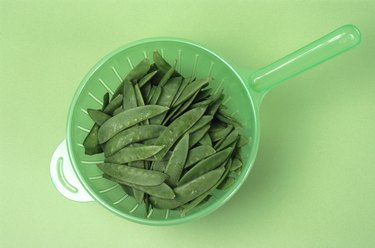Things You\’ll Need
-
1-gallon crock
-
Mixing bowl
-
Heavy plate
-
Slotted spoon
-
Knife
-
4 lbs. green beans
-
1/2 gallon water
-
1/3 cup salt
-
1/2 cup vinegar
-
15 cloves garlic
-
15 sprigs dill
-
30 peppercorns

Green beans are among the many vegetables that hold up well to the process of pickling. Green beans are usually fresh-pack or heat-process pickled, although it is also possible to preserve them with the non-stove method of fermentation pickling. This process can take between one and three weeks. You may choose to rinse pickled green beans before cooking to dilute the salty, spiced flavor. Eat them fresh from the brine as snacks or use them in stews or casseroles where they'll lend their distinct flavor to the other ingredients.
Video of the Day
Step 1
Prepare the green beans for pickling. Sort through them to make sure you are only pickling ripe, healthy beans without blemishes. Wash them thoroughly and trim them to a consistent length (3 to 4 inches).
Step 2
Mix the brine by combining the water, salt and vinegar in a bowl.
Step 3
Place half of the dill, garlic and peppercorns on the bottom of the crock. Pack the green beans on top of the spices.
Step 4
Lay the remaining spices on top of the green beans and pour the brine into the crock until all the beans are covered. Place a heavy plate on top of the beans and spices to keep them submerged under about 2 inches of brine.
Step 5
Store the crock in an area where the temperature is about 70 degrees Fahrenheit. Check the crock daily to see if any white scum has formed on top of the brine, and remove scum with a slotted spoon.
Step 6
Watch for bubbles rising from the beans. This shows fermentation is occurring. The pickling process is complete when the bubbles stop, which usually takes between one and three weeks.
Step 7
Store the beans in the crock in your refrigerator or a cool area (38 degrees Fahrenheit) for up to three weeks after they are pickled. You can store them longer by canning them in jars in their brine.
Tip
Make sure the room where the crock is stored during fermentation doesn't get too warm. Temperatures above 80 degrees Fahrenheit can cause the beans to get too soft.
Warning
Check the consistency of the green beans during fermenting and discard any that become soft or slimy. They can spoil the rest of the batch.




